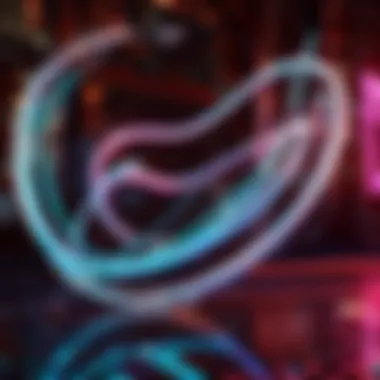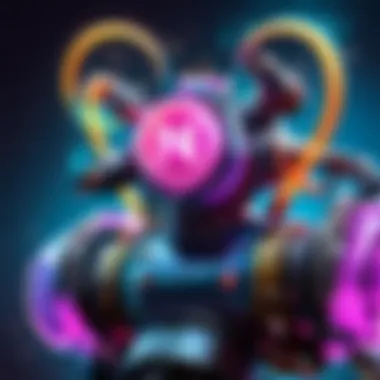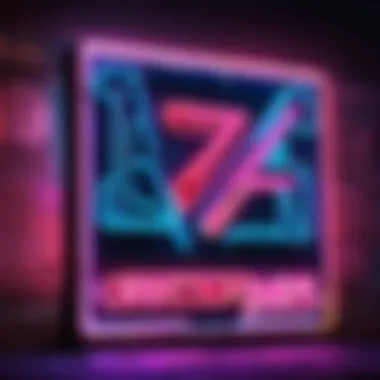Unlocking the Intricacies of Crafting Neon Signs: A Detailed Guide


Neon Making Techniques
Neon sign crafting is an intricate process that involves precise techniques and expert knowledge. Understanding the art of making neon signs entails a deep dive into the fusion of science and creativity. From shaping glass tubes to infusing them with noble gases, each step contributes to the vibrant outcome that captivates onlookers.
Glass Tube Bending
One of the fundamental skills in neon sign production is the delicate art of bending glass tubes. Craftsmen meticulously heat these tubes to malleability, allowing them to create intricate shapes and designs required for the desired signage. This meticulous process demands steady hands and a keen eye for detail.
Gas Filling Process
Once the tubes are bent into shape, the next step involves filling them with noble gases. Neon, argon, and other gases give neon signs their distinctive colors when electrified. The gas filling process requires precision to ensure optimal brightness and longevity of the neon sign.
Electrode Placement and Sealing
At the heart of every neon sign lies the crucial step of electrode placement and sealing. This step ensures the electrical connection needed to ionize the gas within the tubes, leading to the iconic glow associated with neon signs. Proper sealing is essential for the sign's durability and performance over time.
Illumination and Testing
Upon completing the glass bending, gas filling, and sealing processes, the neon sign is ready for illumination and testing. This stage involves electrifying the sign to observe the colorful glow produced by the ionized gases. Thorough testing guarantees the sign meets quality standards before installation.
Introduction to Neon Signs
Neon signs, although often seen as attention-grabbing works of art in the bustling cityscape, are much more than just luminous decorations. In this section, we will unravel the underlying intricacies of neon signs, exploring the fusion of science and artistry that goes into their creation. Delving into the realm of neon sign making provides a profound insight into the meticulous craftsmanship required to produce these iconic illuminated displays that captivate onlookers worldwide.
Understanding Neon as a Noble Gas
The Properties of Neon Gas
Neon gas, known for its distinctive bright red-orange glow when electrified, plays a pivotal role in the creation of neon signs. Its inert nature and ability to emit a vibrant light make it a favored choice among noble gases for signage applications. The unique characteristic of neon gas lies in its stability and minimal reactivity, ensuring a consistent and eye-catching illumination essential for neon signs. Despite its advantages in producing vivid lights, neon gas also has limitations, such as being limited to certain color hues, which restrict the color range available in neon sign fabrication.
Role of Noble Gases in Neon Signage
Apart from neon, other noble gases like argon and helium also contribute significantly to the diverse color palette of neon signs. Argon, for instance, produces blue and lavender hues, while helium creates white and gold-toned lights when energized. By combining different noble gases within glass tubes, artisans can achieve a spectrum of colors, enriching the visual appeal of neon signs. However, the use of multiple gases also adds complexity to the fabrication process, requiring precision in gas filling and electrode placement to ensure optimal functionality and visual impact.
History and Evolution of Neon Signs


The Origins of Neon Lighting
The journey of neon lighting dates back to the early 20th century, with French engineer Georges Claude pioneering the commercialization of neon signs. His revolutionary inventions transformed advertising and signage, paving the way for the widespread adoption of neon lighting for commercial, artistic, and decorative purposes. The distinct glow and allure of neon captured the imagination of the public, propelling its popularity as a preferred medium for signage and artistic expression.
Impact of Neon Signs on Popular Culture
Neon signs have transcended their initial advertising function to become cultural icons synonymous with urban landscapes and retro aesthetics. From vintage storefronts to modern art installations, neon signs have left an indelible mark on popular culture, symbolizing creativity, nostalgia, and vibrant expression. Their influence extends beyond mere luminosity, embedding themselves in the collective memory and visual language of societies worldwide, shaping trends in design, fashion, and visual communication.
Significance and Appeal of Neon Art
Artistic Expression in Neon
Neon as a medium offers artists a versatile platform for creative expression, blending light, color, and form to sculpt captivating visual narratives. The ability to manipulate glass tubes into intricate shapes and designs empowers artists to craft bespoke neon artworks that transcend traditional art boundaries. The luminous quality of neon light adds a dynamic dimension to artistic endeavors, infusing spaces with a surreal, ethereal ambiance that captivates viewers and evokes emotional responses.
Commercial and Aesthetic Value of Neon Signs
In the realm of commerce, neon signs serve as potent branding tools, leveraging their luminosity and distinctiveness to attract and guide customers. The aesthetic appeal of neon signage lies in its ability to stand out amidst the visual clutter of urban environments, acting as beacons of identity for businesses and establishments. Beyond their commercial utility, neon signs contribute to the aesthetic enrichment of public spaces, infusing dull surroundings with splashes of color and character, enriching the visual landscape with their dynamic allure.
Technical Aspects of Neon Sign Making
Neon sign making encompasses a meticulous process that marries scientific principles with artistic ingenuity. The technical aspects play a pivotal role in ensuring the successful creation of vibrant and eye-catching neon signs. Glass bending techniques, gas filling processes, and electrode placement are just a few components that demand attention. Each step requires precision and expertise to transform inert materials into luminous works of art. Understanding the intricacies of these technical aspects is paramount to achieving stunning neon creations.
Glass Bending Techniques
In the realm of neon sign making, the art of bending glass tubes is a critical component that defines the final outcome of the signage. The debate between hand bending and machine bending is a nuanced one, each method offering unique advantages and considerations. Hand bending, with its artisanal touch, allows for more customized and intricate bends that cater to specific design requirements. On the other hand, machine bending provides consistency and efficiency, making it a preferred choice for large-scale productions. The key lies in striking a balance between artistic finesse and manufacturing precision to deliver impeccable neon signage.
Gas Filling Process
The gas filling process, involving the infusion of noble gases into glass tubes, is where the magic of neon signs truly comes alive. Choosing the right noble gases is crucial as different gases produce different colors when excited by electricity. Understanding the characteristics of each gas and their application in creating specific hues is essential for achieving the desired visual impact. Moreover, the process of filling the tubes requires expertise to prevent air pockets and ensure uniform illumination. Mastering the gas filling process is central to achieving the vivid and radiant colors synonymous with neon signs.
Electrode Placement and Wiring
Within the realm of neon sign fabrication, the meticulous placement of electrodes and wiring is vital for the functionality and longevity of the signage. Ensuring robust electrical connectivity is paramount to guarantee consistent illumination and prevent premature failures. Securing electrodes for longevity involves strategic positioning to withstand temperature changes and mechanical stresses. Finding the optimal balance between functionality and durability in electrode placement is key to extending the lifespan of neon signs and maintaining their visual allure in the long run.
Artistic Design and Creativity in Neon
Artistic design and creativity play a pivotal role in the creation of neon signs. The intricate process of crafting neon art requires a keen eye for design and a deep understanding of artistic principles. In this section, we will delve into how artists leverage creative elements to breathe life into neon signs, making them not just visually appealing but also culturally significant. From selecting color schemes to designing intricate patterns, every aspect of artistic design influences the final outcome of a neon sign.


Typography and Fonts in Neon
Impact of Font Choice on Visibility
When it comes to neon signs, the font choice significantly impacts the overall visibility and aesthetic appeal. The right font can make a neon sign stand out in a crowded urban landscape, capturing the attention of passersby with its striking design. Fonts with bold and clear lettering are often preferred for neon signs, ensuring readability from a distance and enhancing the message delivery. The impact of font choice on visibility underscores the importance of selecting fonts that resonate with the intended audience and align with the brand's identity.
Customizing Typography for Branding
Customizing typography for branding purposes allows businesses to differentiate themselves and establish a unique brand identity through neon signs. By customizing fonts to reflect the ethos and personality of the brand, companies can create a lasting impression on customers and reinforce brand recognition. The versatility of neon typography enables businesses to experiment with different styles, sizes, and colors, tailoring each neon sign to align with the brand's visual language. Customized typography adds a personal touch to neon signs, making them not just advertisements but also artistic statements.
Neon Sculptures and Installations
Crafting 3D Neon Artworks
Crafting 3D neon artworks adds a new dimension to traditional two-dimensional neon signage. By incorporating depth and perspective, artists can create immersive and interactive pieces that engage viewers on multiple levels. The process of crafting 3D neon artworks requires meticulous planning and precise execution to transform abstract concepts into tangible sculptural forms. The uniqueness of 3D neon art lies in its ability to transcend traditional boundaries, blurring the line between art and design.
Architectural Integration of Neon Pieces
Integrating neon pieces into architecture opens up endless possibilities for creating dynamic and impactful installations. Whether adorning building facades or accentuating interior spaces, neon pieces can enhance architectural aesthetics and contribute to the overall ambiance. The architectural integration of neon pieces allows artists to reimagine space and transform ordinary environments into immersive visual experiences. By strategically placing neon elements within architectural settings, artists can evoke emotional responses and stimulate viewers' imagination.
Neon Art in Contemporary Culture
Neon in Modern Art Movements
Neon art has seamlessly woven itself into modern art movements, challenging traditional conventions and pushing boundaries in artistic expression. The vibrancy and luminosity of neon colors have become synonymous with contemporary art, captivating audiences and provoking thought. Neon's presence in modern art movements reflects a shift towards innovative mediums and unconventional forms of communication, setting new standards for artistic experimentation and creativity.
Social Commentary through Neon Creations
Through neon creations, artists have found a powerful medium to convey social commentary and critique prevalent societal norms. Neon signs infused with subtle messages or provocative imagery serve as conduits for sparking conversations and raising awareness about pertinent issues. The juxtaposition of neon's playful luminosity with thought-provoking content creates a dynamic tension that challenges viewers to reflect and engage critically with the artwork. By leveraging neon as a tool for social commentary, artists amplify their voices and provoke meaningful dialogue in contemporary culture.
Maintenance and Preservation of Neon Signs
Maintaining and preserving neon signs is crucial in ensuring their longevity and optimal performance. Neon signs are not only artistic creations but also functional pieces of commercial signage that require regular care and attention to maintain their vibrancy and functionality. Proper maintenance not only extends the lifespan of neon signs but also enhances their visual appeal, making them stand out as iconic pieces of art in any setting.
Cleaning and Care Practices


In the realm of neon sign maintenance, cleaning and care practices play a pivotal role in preserving the luminosity and clarity of neon tubes. Two essential aspects of cleaning and care are highlighted below:
Removing Dust and Debris Safely
Removing dust and debris from neon signs is essential to prevent blockages that can obstruct the flow of light, diminishing the overall brightness of the sign. Utilizing safe cleaning methods and gentle tools ensures that neon tubes remain unharmed during the cleaning process. This meticulous practice not only improves the visibility of the sign but also prolongs the life of the neon tubes, maintaining their original brilliance.
Protecting Neon Tubes from Physical Damage
Shielding neon tubes from physical harm is critical to prevent breakages or cracks that can lead to gas leakage and reduced luminosity. By implementing protective measures such as transparent covers or adequate spacing from potential impact sources, the integrity of the neon tubes is safeguarded. This proactive approach to protection minimizes the risk of damages and safeguards the structural integrity of neon signs, preserving their visual impact.
Repairing Faulty Neon Components
Addressing faulty neon components promptly is essential to ensure the seamless operation of neon signs. This section covers key aspects of neon sign repair:
Replacing Damaged Glass Tubes
Replacing damaged glass tubes is a crucial aspect of neon sign maintenance, as any fractures or leaks can compromise the structural integrity of the sign. By carefully removing defective tubes and installing new ones, the functionality and luminosity of the sign are restored. This meticulous process involves aligning electrodes correctly and sealing the tubes securely to prevent gas leakage, ensuring optimal performance.
Troubleshooting Electrical Issues
Effective troubleshooting of electrical issues in neon signs is imperative to identify and rectify wiring or connectivity problems promptly. By conducting thorough inspections and utilizing diagnostic tools, faulty connections or electrical failures can be detected and remedied efficiently. This systematic approach to troubleshooting ensures that the electrical components of neon signs operate seamlessly, maintaining their illuminating effects.
Preservation Techniques for Longevity
Implementing preservation techniques is essential to prolong the lifespan of neon signs and retain their visual allure. This segment explores critical strategies for preserving neon signs:
UV Protection for Neon Colors
Protecting neon colors from UV radiation is vital to prevent fading or discoloration, preserving the vibrancy and saturation of the hues. Incorporating UV-resistant coatings or positioning neon signs away from direct sunlight mitigates the detrimental effects of UV exposure. This proactive measure not only maintains the aesthetic appeal of neon signs but also safeguards their color integrity over time.
Climate Control for Neon Sign Durability
Maintaining optimal environmental conditions is key to ensuring the durability of neon signs in diverse climates. Regulating temperature and humidity levels within the installation area protects neon tubes from thermal stress and moisture-related damage. By creating a stable climate environment, neon signs remain structurally sound and operational, prolonging their longevity and visual impact.
Conclusion: The Enduring Allure of Neon Creations
In delving into the mesmerizing world of neon creations, we encounter the encapsulation of artistry and innovation that defines these luminous works. Neon signs hold a timeless charm that transcends mere illumination, becoming emblematic of creativity and aesthetic allure. The enduring appeal of neon lies in its ability to merge technology with art, transforming everyday spaces into vibrant realms of inspiration and illumination. As we navigate through the intricate process of neon sign-making, we uncover not just a craft, but a form of expression that resonates across generations. The canvas of neon offers artists and designers a dynamic medium to explore shapes, colors, and light in ways that captivate and enchant viewers, making each neon creation a testament to human ingenuity and creativity.
Legacy of Neon Artistry
Neon signs have left an indelible mark on modern design, influencing aesthetic trends and conceptual frameworks across various artistic domains. The Influence of Neon Signs on Modern Design is profound due to its ability to inject spaces with bold, luminous accents that evoke a sense of dynamism and modernity. The distinctive glow of neon has become a symbol of contemporary aesthetics, offering designers a versatile tool to carve out unique visual identities and immersive experiences. Despite its brilliance, neon's design impact extends beyond mere aesthetics, becoming a hallmark of progressive thinking and experimental design practices that push boundaries and challenge conventions. The allure of neon in modern design lies in its ability to transform ordinary environments into extraordinary showcases of creativity and innovation.
Future trends in Neon Art and Design forecast a continuation of neon's reign as a prominent medium in artistic expression and commercial design. The adaptive nature of neon as a creative tool ensures its relevance in an ever-evolving design landscape, where innovation and tradition intersect to shape new aesthetic paradigms. The luminescent potential of neon offers endless opportunities for experimentation and reinvention, allowing artists and designers to push the boundaries of conventional design and embrace the allure of dynamic illumination. The future of neon art and design holds the promise of further integration into diverse creative fields, from fine art to interior design, sparking new waves of inspiration and redefining the boundaries of artistic expression.



